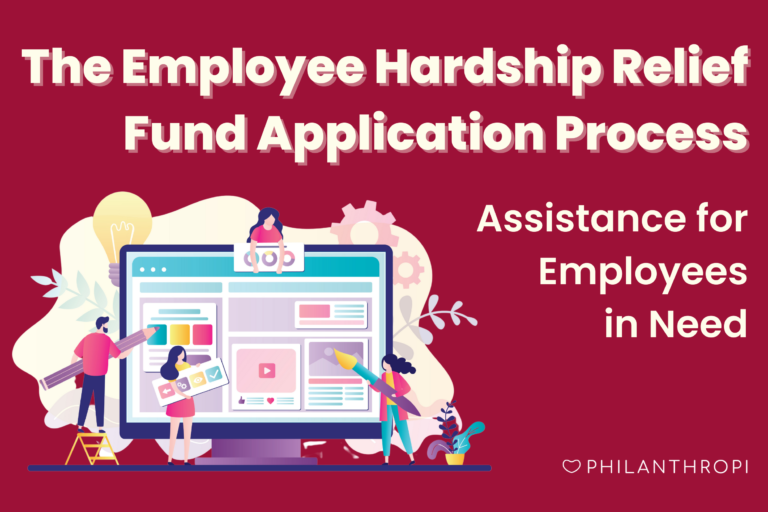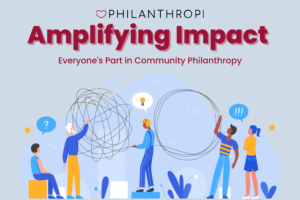In times of financial hardship, employees often face significant challenges that can impact their overall well-being, which can impact their job performance. Recognizing the importance of supporting employees during such difficult circumstances, many organizations have established employee hardship funds. These funds provide crucial assistance to employees facing financial difficulties. As a full-service provider of hardship relief funds, Philanthropi is here to assist your employees with their application process. We want to ensure that employees understand the employee hardship fund application process in full.
Understanding Employee Hardship Funds
Employee hardship funds are dedicated programs established by employers to assist employees who are experiencing financial hardships. These funds temporarily relieve employees facing unexpected expenses, medical bills, or other financial burdens due to a qualified disaster or qualifying personal hardship event. These funds are sometimes referred to as qualified disaster relief payments.
The fund is typically supported by employer contributions, voluntary contributions from employees, or a combination of both.
Eligibility Criteria
Before applying for an employee hardship fund, or for a qualified relief payment, it is essential to understand the eligibility criteria. Each organization may have its own specific guidelines for the hardships covered after a qualified disaster. However, common criteria may include events such as serious illness or injury, impact to a primary residence, or victim of a violent crime. Hardships stemming from these events might consist of financial assistance for rent and bills or financial assistance for repairs to damaged property. Every hardship relief fund with Philanthropi will follow different criteria or guidelines set out by the organization’s wants and needs for their specific fund. We are here to help you customize your solution.
Charitable Class:
The charitable class must be large enough or sufficiently indefinite that the community, rather than a pre-selected group, benefits when a charity assists. For example, a charitable class could include all the individuals in a city, county, or state. This charitable class is large enough that the potential beneficiaries cannot be individually identified, and providing benefits to this group would benefit the entire community.
Employers may select who is part of their charitable class, such as full-time or part-time employees. Typically, you must be an active employee of the organization to be eligible for the fund.
Financial Need:
Generally, a disaster relief or emergency hardship organization must make a specific assessment that a recipient of aid is financially or otherwise in need. Individuals do not have to be destitute to be financially needy; they may lack the resources to obtain basic necessities. Under established rules, charitable funds cannot be distributed to individuals merely because they are victims of a disaster. Therefore, an organization’s decision about how its funds will be distributed must be based on an objective evaluation of the victims’ needs at the time the grant is made. The scope of the assessment required to support the need for assistance may vary depending on the circumstances.
You must demonstrate your financial need by providing supporting documentation, such as proof of income, outstanding bills, or medical expenses. Hardship relief funds are not intended to assist those whose funds are held in savings accounts; they are available to those experiencing true financial hardship.
Hardship Circumstances:
Employee hardship funds are available to individuals facing unforeseen circumstances, such as sudden illness, natural disasters, or significant personal emergencies, including but not solely limited to:
- temporarily in need of food or shelter when stranded, injured, or lost because of a disaster
- temporarily unable to be self-sufficient as a result of a sudden and severe personal or family crisis
- Such as victims of violent crimes or physical abuse
- in need of long-term assistance with housing, childcare, or educational expenses because of a disaster
- in need of counseling because of trauma experienced as a result of a disaster or a violent crime
A few examples of a qualified disaster are:
- results from terrorist or military actions
- results from an accident involving a common carrier
- is a Presidentially declared disaster
- is an event that the Secretary of the Treasury determines is catastrophic
A few examples of a qualifying personal hardship are:
- Non-routine medical expense
- Serious illness or injury
- Fire, flood, or natural disaster (not a Qualified Disaster)
- Domestic violence
- Military deployment
- Unemployment issues with family
- Housing – Extraordinary expenses not covered by insurance
Review your organization’s guidelines to determine if you meet the eligibility criteria before proceeding with the application.
Application Process
Applying for an employee hardship fund usually involves the following steps:
1. Review Application Requirements:
Carefully read through the fund’s application requirements, guidelines, and supporting documents needed for your submission. Please note that there may be a limited timeline for how long you have after a qualified hardship to apply. Additionally, there may be limitations on how many times you can receive a hardship relief grant per year.
2. Gather Supporting Documentation:
Collect the necessary documents to support your application, such as pay stubs, medical bills, or any relevant financial statements. Ensure that these documents are up-to-date and accurately reflect your current financial situation. These documents will likely need to be printed on the company’s letterhead to ensure their validity.
3. Complete the Application Form:
Fill out the employee hardship fund application form accurately and provide all the requested information. Be honest and thorough in explaining your financial hardship circumstances. While the selection committee may be empathetic to your circumstances, it is important that they review your claim by only the information you provide in the application. Always ensure that your documentation is submitted in full.
4. Submit the Application:
Once you have completed the application form and gathered all the required documentation, submit your application through the designated channel. This may include submitting it electronically via an online portal or delivering it to the HR department.
Confidentiality and Privacy
Employee hardship fund applications are typically handled with utmost confidentiality and privacy. Understand that the information you provide in your application will be treated as sensitive and protected. With Philanthropi, we take your privacy seriously. Our online form for submissions feeds all information into the Philanthropi system directly. Your organization and its staff are not involved in the decision-making process. Additionally, only relevant individuals from the Philanthropi team are involved in the review process.
Application Review and Assistance
After submitting your application, the employee hardship fund administrators will review your case based on the eligibility criteria and the available funds. The review process may take some time as the administrators carefully assess each application. At Philanthropi, we review applications on an ongoing basis to ensure that funds are processed for approval as soon as possible. Additionally, if an application does not include all of the information required with the first submission, Philanthropi will work with the employee directly to solidify all information before making an unbiased final decision.
If approved, you will receive assistance based on the amount allocated by the fund and the nature of your financial hardship.
If denied, consider contacting the fund administrators to understand the reasons behind the decision. They may provide guidance on alternative resources or suggest steps you can take to improve your financial situation. Philanthropi prides itself on communication and transparency, so know that we are here to assist you in any way possible. While it is impossible to approve all application submissions, we are committed to working with you to find the best solution possible.
Employee hardship relief funds or qualified disaster relief funds offer valuable assistance to employees facing financial difficulties. However, the employee hardship relief fund application process can sometimes be confusing or overwhelming. By understanding the eligibility criteria, carefully completing the application process, and ensuring the confidentiality of your information, you can maximize your chances of receiving the support you need. If your organization provides an employee hardship fund, take advantage.
If your organization does not currently have an employee hardship relief fund, contact Philanthropi. We can assist you with customizing a solution for your organization.



